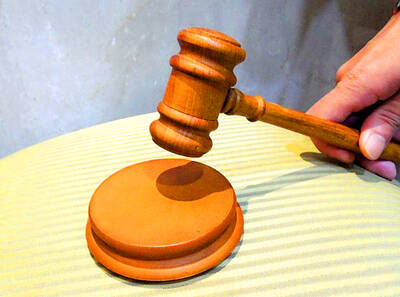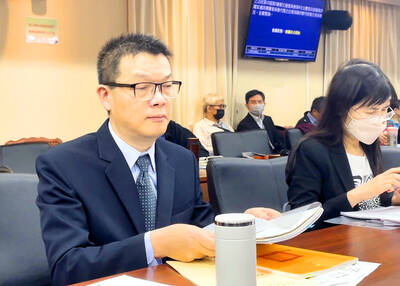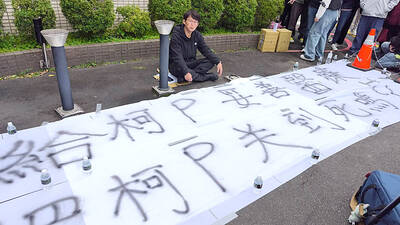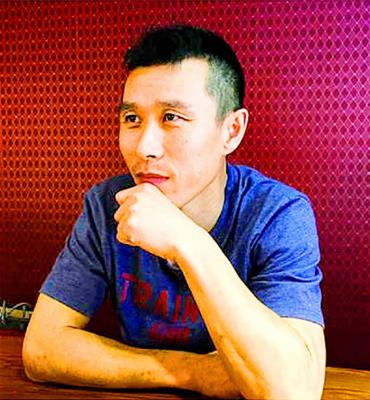About 300 people die per year as a result of someone driving after taking medication, the Federation of Taiwan Pharmacists Associations said yesterday, urging people to avoid driving after taking drugs.
Traffic accidents were the eighth-leading cause of death in Taiwan last year, and among the more than 3,000 people who died in traffic accidents last year, an estimated 10 percent of them died as a result of someone driving under the influence of drugs, federation chairman Huang Jin-shun (黃金舜) said.
Many people are aware of the risks of driving after consuming alcohol, but the risk of driving after taking medications is less known by the general public, Huang said, adding that they can alter a person’s mental state and reaction time, seriously affecting their ability to drive.

Photo: Tsai Ssu-pei, Taipei Times
A poll found that about 35 percent of drivers surveyed said they take at least one type of drug weekly that could affect their ability to drive, he said.
About 6 million people in Taiwan regularly take medications, and many of them also often drive afterward, he said.
A survey by the federation and the hospital showed that the most common drugs taken before driving that resulted in a traffic incident are antihypertensive drugs, followed by sleeping pills and muscle relaxants, Taipei City Hospital clinical pharmacy head Pao Jiunn-bey (鮑俊蓓) said.
The hospital last year began promoting awareness of driving after taking drugs, Taipei City Hospital Department of Pharmacy director Wu Su-jhen (吳淑娟) said.
It classified drugs into four levels according to their possible effect on driving, starting with level 0, which are drugs that do not affect driving, Wu said.
People taking level 1 drugs — such as antihypertensives, painkillers, codeine (less than 20mg), and cough and cold remedies — should be cautious and carefully read the usage instructions before driving.
For level 2 drugs, people should “be very careful” and ask a healthcare professional for advice if they need to drive after taking them. They include anti-depressants, anesthetics, antispasmodics and certain hypoglycemic drugs.
Level 3 drugs are considered dangerous and should be avoided before driving, or only taken after an assessment by healthcare professionals. They include certain types of antipsychotics, sleeping pills, nonbenzodiazepines (also known as Z-drugs), most anxiolytics, mydriatics and certain types of muscle relaxants.
Some European countries require pharmacies to print warning labels on drugs and ask pharmacists to inform people about the risks of driving after taking them, the federation said.
Taipei City Hospital superintendent Hsiao Sheng-huang (蕭勝煌) said it is more difficult to charge people on medication involved in a traffic incident, as drug testing is not as easy as testing for alcohol as metabolism rates vary per person.
The federation and the hospital said it would continue to train pharmacists to carefully instruct patients about the risks of driving after taking drugs.

The High Prosecutors’ Office yesterday withdrew an appeal against the acquittal of a former bank manager 22 years after his death, marking Taiwan’s first instance of prosecutors rendering posthumous justice to a wrongfully convicted defendant. Chu Ching-en (諸慶恩) — formerly a manager at the Taipei branch of BNP Paribas — was in 1999 accused by Weng Mao-chung (翁茂鍾), then-president of Chia Her Industrial Co, of forging a request for a fixed deposit of US$10 million by I-Hwa Industrial Co, a subsidiary of Chia Her, which was used as collateral. Chu was ruled not guilty in the first trial, but was found guilty

DEADLOCK: As the commission is unable to forum a quorum to review license renewal applications, the channel operators are not at fault and can air past their license date The National Communications Commission (NCC) yesterday said that the Public Television Service (PTS) and 36 other television and radio broadcasters could continue airing, despite the commission’s inability to meet a quorum to review their license renewal applications. The licenses of PTS and the other channels are set to expire between this month and June. The National Communications Commission Organization Act (國家通訊傳播委員會組織法) stipulates that the commission must meet the mandated quorum of four to hold a valid meeting. The seven-member commission currently has only three commissioners. “We have informed the channel operators of the progress we have made in reviewing their license renewal applications, and

Taiwan People’s Party (TPP) Chairman Huang Kuo-chang (黃國昌) yesterday appealed to the authorities to release former Taipei mayor Ko Wen-je (柯文哲) from pretrial detention amid conflicting reports about his health. The TPP at a news conference on Thursday said that Ko should be released to a hospital for treatment, adding that he has blood in his urine and had spells of pain and nausea followed by vomiting over the past three months. Hsieh Yen-yau (謝炎堯), a retired professor of internal medicine and Ko’s former teacher, said that Ko’s symptoms aligned with gallstones, kidney inflammation and potentially dangerous heart conditions. Ko, charged with

Taiwan-based publisher Li Yanhe (李延賀) has been sentenced to three years in prison, fined 50,000 yuan (US$6,890) in personal assets and deprived political rights for one year for “inciting secession” in China, China's Taiwan Affairs Office spokesman Chen Binhua (陳斌華) said today. The Shanghai First Intermediate People’s Court announced the verdict on Feb. 17, Chen said. The trial was conducted lawfully, and in an open and fair manner, he said, adding that the verdict has since come into legal effect. The defendant reportedly admitted guilt and would appeal within the statutory appeal period, he said, adding that the defendant and his family have